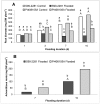Expression of root-related transcription factors associated with flooding tolerance of soybean (Glycine max)
- PMID: 25268626
- PMCID: PMC4227181
- DOI: 10.3390/ijms151017622
Expression of root-related transcription factors associated with flooding tolerance of soybean (Glycine max)
Abstract
Much research has been conducted on the changes in gene expression of the model plant Arabidopsis to low-oxygen stress. Flooding results in a low oxygen environment in the root zone. However, there is ample evidence that tolerance to soil flooding is more than tolerance to low oxygen alone. In this study, we investigated the physiological response and differential expression of root-related transcription factors (TFs) associated with the tolerance of soybean plants to soil flooding. Differential responses of PI408105A and S99-2281 plants to ten days of soil flooding were evaluated at physiological, morphological and anatomical levels. Gene expression underlying the tolerance response was investigated using qRT-PCR of root-related TFs, known anaerobic genes, and housekeeping genes. Biomass of flood-sensitive S99-2281 roots remained unchanged during the entire 10 days of flooding. Flood-tolerant PI408105A plants exhibited recovery of root growth after 3 days of flooding. Flooding induced the development of aerenchyma and adventitious roots more rapidly in the flood-tolerant than the flood-sensitive genotype. Roots of tolerant plants also contained more ATP than roots of sensitive plants at the 7th and 10th days of flooding. Quantitative transcript analysis identified 132 genes differentially expressed between the two genotypes at one or more time points of flooding. Expression of genes related to the ethylene biosynthesis pathway and formation of adventitious roots was induced earlier and to higher levels in roots of the flood-tolerant genotype. Three potential flood-tolerance TFs which were differentially expressed between the two genotypes during the entire 10-day flooding duration were identified. This study confirmed the expression of anaerobic genes in response to soil flooding. Additionally, the differential expression of TFs associated with soil flooding tolerance was not qualitative but quantitative and temporal. Functional analyses of these genes will be necessary to reveal their potential to enhance flooding tolerance of soybean cultivars.
Figures






References
-
- Fausey N.R. Subirrigation/drainage systems for water table management in the Midwest; Proceedings of the International Irrigation Exposition and Technical Conference; Atlanta, GA, USA. 20 November 1994; pp. 242–246.
-
- VanToai T., Beuerlein J.E., Schmitthenner A.F, Martin S.K. Genetic variability for flooding tolerance in soybeans. Crop Sci. 1994;6:1112–1115.
-
- Sullivan M., VanToai T.T., Fausey N., Beuerlein J., Parkinson R., Soboyejo A. Evaluating on-farm flooding impacts on soybean. Crop Sci. 2001;41:93–100.
-
- Mittler R. Abiotic stress, the field environment and stress combination. Trends Plant Sci. 2006;11:15–19. - PubMed
-
- Rosenzweig C., Tubiello F.N., Goldberg R., Mills E., Bloomfield J. Increased crop damage in the US from excess precipitation under climate change. Glob. Environ. Chang. 2002;12:197–202.
Publication types
MeSH terms
Substances
LinkOut - more resources
Full Text Sources
Other Literature Sources

